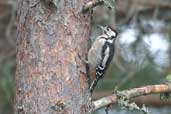|
Great Spotted Woodpecker (Dendrocopos
major)
|
 |
Scotland
The Great Spotted Woodpecker is found throughout Europe and extends through central and southern Siberia to Japan and
south-east Asia. It is by far the most common black and white woodpecker in most of its range.
It is found in a wide variety of habitats provided there are trees for feeding and of a sufficient size to provide nest
holes.
|
|
Like all "Spotted" Woodpeckers it has a basically black and white plumage but the Great Spotted has a
deep red vent, no streaks on the flanks and two large white patches on the wings. The male has a small red patch on the back of the head, the female
has no red on the head and the juvenile (seen in this photo) has an all red crown and paler red on the vent. |
|
It eats mainly insects which it finds on the bark of trees or on dead trees along with wood-boring beetles and
larvae. It climbs the trees using its stiff tail feathers for support and has an exceptionally long and harpoon-shaped tongue with which to extract
its prey. In winter it often eats tree seeds mainly from conifers. Other items in the diet are birds' eggs and nestlings.
The drumming heard mainly from January to June is not a result of the search for food but is a contact sign during pair
formation. It usually consists of burst of about a dozen strikes in the course of half a second.
|
|
|
